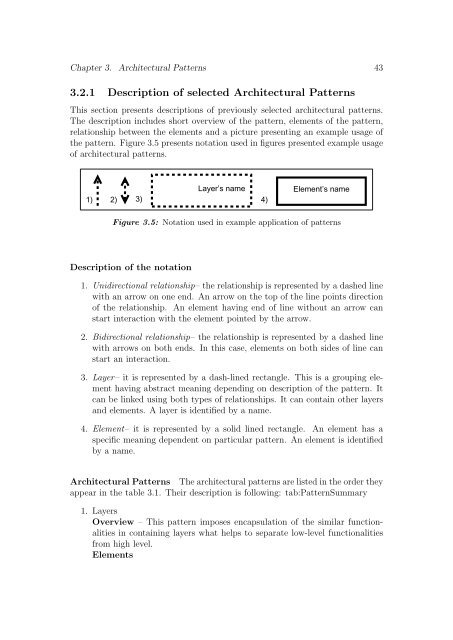Migration of a Chosen Architectural Pattern to Service Oriented ...
Migration of a Chosen Architectural Pattern to Service Oriented ...
Migration of a Chosen Architectural Pattern to Service Oriented ...
Create successful ePaper yourself
Turn your PDF publications into a flip-book with our unique Google optimized e-Paper software.
Chapter 3. <strong>Architectural</strong> <strong>Pattern</strong>s 433.2.1 Description <strong>of</strong> selected <strong>Architectural</strong> <strong>Pattern</strong>sThis section presents descriptions <strong>of</strong> previously selected architectural patterns.The description includes short overview <strong>of</strong> the pattern, elements <strong>of</strong> the pattern,relationship between the elements and a picture presenting an example usage <strong>of</strong>the pattern. Figure 3.5 presents notation used in figures presented example usage<strong>of</strong> architectural patterns.Layer’s name1) 2) 3) 4)Element’s nameFigure 3.5: Notation used in example application <strong>of</strong> patternsDescription <strong>of</strong> the notation1. Unidirectional relationship– the relationship is represented by a dashed linewith an arrow on one end. An arrow on the <strong>to</strong>p <strong>of</strong> the line points direction<strong>of</strong> the relationship. An element having end <strong>of</strong> line without an arrow canstart interaction with the element pointed by the arrow.2. Bidirectional relationship– the relationship is represented by a dashed linewith arrows on both ends. In this case, elements on both sides <strong>of</strong> line canstart an interaction.3. Layer– it is represented by a dash-lined rectangle. This is a grouping elementhaving abstract meaning depending on description <strong>of</strong> the pattern. Itcan be linked using both types <strong>of</strong> relationships. It can contain other layersand elements. A layer is identified by a name.4. Element– it is represented by a solid lined rectangle. An element has aspecific meaning dependent on particular pattern. An element is identifiedby a name.<strong>Architectural</strong> <strong>Pattern</strong>s The architectural patterns are listed in the order theyappear in the table 3.1. Their description is following: tab:<strong>Pattern</strong>Summary1. LayersOverview – This pattern imposes encapsulation <strong>of</strong> the similar functionalitiesin containing layers what helps <strong>to</strong> separate low-level functionalitiesfrom high level.Elements
















